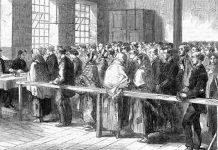A typical summer barbecue for four people releases more greenhouse gases into the atmosphere than an 80-mile car journey, according to a group of scientists studying the impact of our food choices on the environment.
Scientists from across the UK have come together to shine a spotlight on how consumer decisions on diet, as well as new technologies, could help reduce global warming.
Their work is being showcased this week at the Royal Society Summer Science Exhibition, held at the UK’s national scientific academy from 1-7 July 2019. The ‘Take a Bite out of Climate Change’ exhibit will take visitors on a journey from ‘farm to flush’ to explore greenhouse gas emissions (GHGE) at all stages of food production, processing, supply and consumption.
The exhibit team, led by the University of Manchester and including researchers from Lancaster University, brings together academics from food resilience programme N8 Agrifood and innovative technology solutions from the STFC Food Network+.
Lead scientist, Professor Sarah Bridle from the University of Manchester, said: “Food contributes about 25% of all greenhouse gas emissions. As the barbecue season gets underway, people might like some food for thought about the impact of their choices on the environment.
“Did you know for example that a 100g medium-sized beef burger releases enough greenhouses gases to fill more than 60 balloons? That’s equivalent to driving more than six miles by car. By switching to chicken you could reduce that to less than 15 balloons.
“By making a few small changes to our diets such as swapping beef for chicken, a fizzy drink to tap water, a cheese sandwich to a peanut butter sandwich, or a fry-up breakfast to porridge we can make a significant impact.”
Dr Ali Birkett, a terrestrial ecologist and research promotion co-ordinator at the Lancaster Environment Centre, will be joining the team in London as an ‘Expert Communicator’, hot from the Glastonbury Festival, where she has been taking science to the people with the Sex & Bugs & Rock ’n Roll project.
She has helped to design Farming for the Future, one of the ‘games’ featured in the exhibition: using a model of a real farm, visitors can take actions to improve its sustainability and reduce emissions, and learn about the science behind our food system.
“They can add in a wind turbine, add or remove livestock, change the amount of fertiliser used. It helps them to understand the implications of different choices and also shows the balancing act farmers have between their survival as a business and environmental considerations – putting in a wind turbine might be wonderful but farmers have to be able to invest large amount of money to do this.
“It’s meant to be fun as well as informative; it’s like playing with a children’s toy farm but with a serious message. It’s all about having conversations and enabling people to talk to researchers and ask questions. I love enthusing people about the science and making it more accessible.
“We think people will be surprised by how much the food industry is involved in greenhouse gas emissions. I expect to have a lot of conversations about the choices the food industry is making, as well as choices we can make ourselves of what we can choose to consume.”







